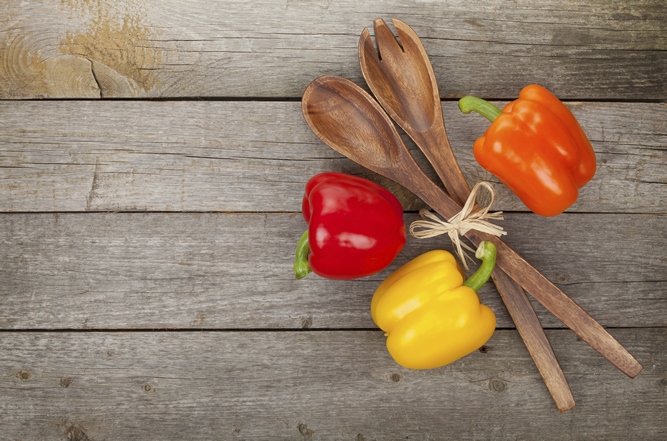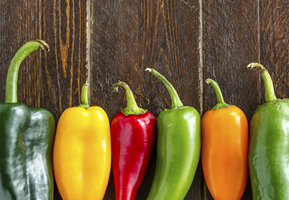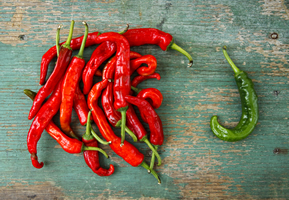A.Vogel search
When the internal search is activated, personal data such as your IP address is transmitted to our search engine Cludo. Data is thus transferred to a third country. Please click here if you want to display the internal search. You can find more information on data protection here: Privacy policy.
Peppers
Peppers, also known as capsicums are botanically a fruit, though often considered to be a vegetable in culinary terms. They come in a range of vibrant colours, indicating the various stages of ripeness of the fruit. Though native to Central and South America, they were carried to Spain in 1493 and they are now commonly associated with the Mediterranean diet, in which their sweet flavour makes them popular in recipes, when eaten both raw or cooked.

An Introduction to Peppers
Peppers are of the species Capsicum annum. Although from the same family as chillies, peppers are not spicy as they do not contain capsaicin; the chemical which makes chillies burn when they touch mucous membranes. The flavour of peppers alters according to their colour, with green peppers being unripe and slightly bitter, to red peppers being very ripe and very sweet.
Peppers thrive in warm conditions, so growing them in a greenhouse or a pot (in a sunny spot) gives the greatest yield of fruit. They are in season from May to September, making them a great addition to summer salads.
Varieties of Peppers
 Peppers can largely be split into two main varieties; sweet peppers and hot or chilli peppers. Sweet peppers include the highly popular Bell peppers. Though these are most commonly sold as green, yellow orange or red (the progressive stages of ripeness) bell peppers can also be purple, brown or white. Pimento peppers are sweet peppers which are much smaller than bell peppers, while other varieties such as the Big Bertha or Goliath peppers can grow to over 1lb.
Peppers can largely be split into two main varieties; sweet peppers and hot or chilli peppers. Sweet peppers include the highly popular Bell peppers. Though these are most commonly sold as green, yellow orange or red (the progressive stages of ripeness) bell peppers can also be purple, brown or white. Pimento peppers are sweet peppers which are much smaller than bell peppers, while other varieties such as the Big Bertha or Goliath peppers can grow to over 1lb.
Hot or chilli peppers produce a chemical called capsaicin which makes them spicy. The level of heat ranges from very mild to extremely hot, depending on the type of pepper. The Scoville Scale measures the heat of chilli peppers, from 0 to over 2 million. Jalapeno peppers are around level 2000, Bird’s eye chillies up to level 100,000 and the Carolina reaper is the hottest chilli, at level 2,200,000.
Nutritional information
 Peppers are packed with vitamins and antioxidants, with 100g pepper providing 134% of your daily requirement of vitamin C - more than twice the amount than in an orange.
Peppers are packed with vitamins and antioxidants, with 100g pepper providing 134% of your daily requirement of vitamin C - more than twice the amount than in an orange.
Alfred Vogel identified that peppers also ‘contain plenty of Vitamin A,’ as well as vitamins K and B6. Peppers contain very little saturated fat or cholesterol. Red peppers are far higher in nutrients than green peppers.
100g serving:
31 kcal, 1g protein, 0.3g fat, 6g carbohydrate, 2.1g fibre
Health benefits
 Getting enough antioxidants each day helps to keep your cells healthy and your immune system fighting fit, as antioxidants reduce oxygen damage to cells. Peppers, particularly red peppers, are high in such antioxidants, including vitamin C, so if you feel your immune system needs a boost, peppers are a good choice. The action of vitamin C on the immune system may also help to ease symptoms of hayfever.
Getting enough antioxidants each day helps to keep your cells healthy and your immune system fighting fit, as antioxidants reduce oxygen damage to cells. Peppers, particularly red peppers, are high in such antioxidants, including vitamin C, so if you feel your immune system needs a boost, peppers are a good choice. The action of vitamin C on the immune system may also help to ease symptoms of hayfever.
Peppers are also high in the B vitamins. These vitamins help the body to gain energy from the food we eat, and also to form red blood cells. Research suggests that peppers help increase metabolism, and it is likely to be down to the B vitamin content of peppers. Vitamin B6 is also a natural diuretic helping to prevent or reduce symptoms of hypertension or bloating.
Fibre helps to keep the digestive system healthy and bowel movements regular, so it is important to include enough fibre in the diet. Peppers are a good source of fibre, particularly the skins. Fibre also helps with weight management as it keeps you feeling full for longer.
Pepper recipes
Fried Egg in Bell Pepper
Pepper Stuffed with Lentils
Tomato and Pepper Salsa
A.Vogel Blog – Natural and Healthy
Inspiration for a healthy life!



